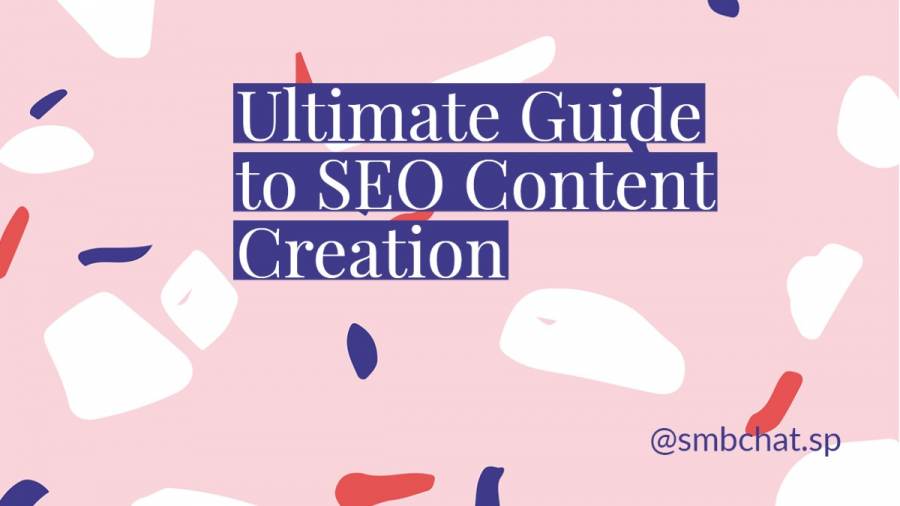Road to 1 Million Page Views: The Ultimate Guide to Creating Killer Website Content
Before we get to creating a kick-ass website content strategy, step back and think about the essence of content for a while.
It is as true now as when Bill Gates said it back in 1996 , “content is king, and every one shall bow”.Okay, we may have added the second part, but that doesn’t make it any less true.
Today, you’re always a few well-written blogs, expertly curated websites, and exquisite landing pages from your next lead(or 10,000).
This article will teach you the intricacies of web content, building a solid strategy, measuring progress and everything in between.
Prerequisites: What Do I Need to Create Epic Website Content
First day jitters, where the heck do I start? You’re not alone, everyone has been there languishing in a similar pool of indecisiveness.
Well, you could just take your laptop, open Google Docs, and start typing away at your first piece. If only it was that easy.
Unfortunately, like everything else, you need a well-laid-out plan and these must-have ingredients to create good website content, and before that, you need to get a few things straight. They include:
1. Why am I Writing
Seeing the end from the beginning is the most essential aspect of website content development. That said, knowing your intent will go a long way in helping you define your tone, focus your resources and have a way forward.
For the purpose of brevity, there are 4 major reasons you’ll be writing website content, they include:
- Lead generation
- Brand awareness
- Education
- Thought Leadership
Are you writing your article to educate your audience or to generate leads (or both), these are some of the questions you will be answering at this stage.
2. Who am I Writing For?
Somebody somewhere is eventually supposed to read your website content, crazy idea, right? Well, that’s unless you’re writing an online diary or journal.
The million-dollar question is who?
Up there with intent, defining your audience is the most decisive factor in the success of your website content.
You can paint a comprehensive picture of your target audience with the knowledge of the following factors:
- Gender (male vs female)
- Age or Generation (baby boomer, gen x, gen y, gen z)
- Mobile vs. desktop
- Most frequented media channels (Twitter, Instagram, Facebook)
- Audience preferences, beliefs, and philosophies
- Buyer behavior (impulsive, decisive, research-intensive)
Here are a few actionable tips to help you define your target audience:
- Define your existing customers ( age, gender, preferences)
- Collect demographic data on your target audience
- If its a new business, research your competition using tools such as SPYFU
- Research using the Twitter audience insights features for advertisers (ads. twitter>followers>audience insights)
- Leverage default channel grouping in Google Analytics to group your audience by age, gender, and location
- Pay-per-click advertising such as using Google Ads is an excellent way to gain insights into the demographics of your audience.
3. How Will I Measure Progress?
Now that you have your intent and goals laid out, you have to measure how far (or near) you are to achieving these targets.
Metrics are essential for measuring the efficacy of your current website content strategy, sealing elusive loopholes, and data-driven decision-making.
Some of the metrics that will help paint an accurate picture of your website content include:
- Time-per-session
- Bounce rate
- Pages per visit
If that’s not enough, you can go even further to metrics such as return on investment(ROI) or Return on Ad Spend (ROAS) to put your progress into perspective.
4. What tools do I Require?
Website content is one of the few professions that you can begin with a laptop a network connection and the determination of a toddler about to say those first,few, monumental words.
However, the more you write- the fun will wear off–and aspects such as productivity, efficiency, and quality become important.
You’ll soon find yourself on a shopping spree- not for clothes, flowers, or snacks-but for the tools that promise to make your work a bit easier.
If you’re a solo writer, here are a few tools that will help you navigate the murky waters of website content:
- A text editor (Google Docs or Microsoft Word)
- A spell checker such as Grammarly, One Text, and Hemingway
- Keyword research, SEO, and content optimization tools eg (Frase.io, MarketMuse, and SemRush)
- Free stock photo sites (Pexels, Pixabay, Unsplash)
- Content marketing analysis tools (Google Analytics, Social Mention, and Social bakers)
If you have a team of writers working for you, here’s your toolbox:
- A productivity tool Asana, Trello, and Welcome
- Communication tool (Slack, Hangouts, or WhatsApp)
- Time tracking software (TimeSheets, Time Doctor, and Zoho Projects)
- A content calendar
If you’re outsourcing your writing or hiring a copywriter, here’s your checklist:
- A professional content company ( Zoey Writers, Brafton, ExpressWriters)
- Content mills or job sites (Verblio, TextMaster, Rightly Written)
- Workflow management software (Monday, Hive, and Kissflow)
- Invoicing software (Bonsai, Xero, and Freshbooks)
Relevant reading:
8 Golden rules to creating outstanding content
Step-by-Step Guide to Demystifying Website Content
Now that you have an idea of all the prerequisites, here is a step-by-step breakdown that will take anyone from a complete noob to knowing a thing or two about website content.
Here are 13 steps to building something special on your own small corner of the internet, Enjoy:
1. Customer Centricity is Key to Selling Content
Just take a step back and think about how many self-centered websites you come across. Often, they’ll spot big portraits of the business owner–with a cheek-to-cheek-grin, a collection of their trophies, and lifelong achievements.
Let's not forget the endless paragraphs dedicated to their views of the future, their so-called “values” and whatnot.
And it’s only natural. Left to their own devices most website content creators will gravitate towards self-appreciating copy that marvels about their products, features, and milestones.
Hey, but where does this leave your customer?
Nice question–The key to writing great website content is customer-centricity, which is French for selflessness. Look at your reader as a human, embrace their perspective and walk a few miles in their shoes.
You’ll soon realize that they too have problems, aspirations, and things that keep them restless and awake at night; and if they’re ever reading something, it will always be about these things.
With that in mind, writing content that shines a light on their pain points, gives perspective, and shows a way forward becomes effortless. You can do this by:
- Creating and using buyer personas
- Leveraging Google analytics to discover audience preferences
- Taking customer feedback and reviews seriously
- Migrating from outbound marketing to inbound marketing
2. Nothing Can Make Up for Mediocre Writing
On a scale of one to Zoey, how epic is your writing? Does it keep your readers hooked, inspire them to take action, and leave them wanting more?
Unfortunately, there is no way around great writing; every inspirational website or blog that you come across almost always has an army of illustrious writers toiling in the background.
We all wish that great storytelling, masterful curation, and riveting writing complete with a matching delivery was a gift Santa gave random websites once every Christmas.
Sadly, it’s a deliberate plan, hatched in marketing departments, developed over time and brought to life with impeccable craftsmanship.
Fortunately, you don’t have to be a pilot to fly, subsequently, you can always get a group of experienced and battle-tested writers to fight this war on your behalf.
If that’s not an option, you’re lucky because great writing is something you can learn. An excellent place to start is with the following steps:
- Read a lot, good writers are almost always avid readers
- Visit other blogs and websites for inspiration
- Write frequently as practice makes perfect
- Jot down good ideas whenever they come (inspiration comes from unlikely places)
3. SEO is no Longer an Option; It’s a Necessity
By now, SEOs are running out of creative ways of stressing the importance of Search Engine Optimization (SEO).
That said, your epic, awesome and incredible website or blog is of no good use if it's stuck on page 31 of Google.
Enough with that, here are a few actionable tips to help with your on-page SEO:
- Aim for the highest-quality page content
- Write brief, optimized and captivating page titles
- Ensure that your blog has a compelling meta description
- Optimize your title tags, headers, and meta descriptions with search keywords
- Optimize your URL with search keywords
- Add alt-text to your images
Here are a few others to help with your off-page SEO:
- Create a robust link-building strategy
- Enable comments and engagements with your readers
- Post your answer on forums such as quora and Reddit
- Be active on social media
4. Write Like a Human
Conversational writing eats theoretical writing for breakfast, in all senses of the word. You can rest assured that your target audience didn’t sign up for a condescending lecture by some stranger on the internet.
On the contrary, audiences warm up and open up to a voice that they can relate with, a tone they’re familiar with and writing that speaks to them.
Conversational writing humanizes your brand, scales the customer's walls of skepticism, and breaks the ice—laying the foundation for interesting relationships that result in life-long engagements.
That said, this is as easy said as it is done, and you can start on your journey to conversational writing with the following tips:
- Use tools like Hemingway and Grammarly to view the readability of your articles and compare them to engagement
- Use the second person pronoun “You” in your writing
- Embrace the active voice instead of the passive voice in your writing
- Always write as if you’re writing to one person and not a group of people
- Relate with your audiences in your writing
- Use contraptions e.g don’t instead of “do not” and “they’re” instead of “they are”
- Don’t fill your writing with jargon or industry terms
- Use personalization where possible
5. Don’t OverSell, Provide Value Instead
Congratulations, your products are of impeccable quality, your prices are dollar store competitive and your value is unmatched on this side of the hemisphere.
Regardless, your customers don’t value this information, and they won’t take your word for it just by the mere fact that you mention it.
The best approach to take is to put all the positive aspects of your product in the context of your customer's pain points and concerns and provide value-based marketing.
Assume that your product is neither the cheapest nor highest quality your client can find, but one that has the potential to make their lives a bit more convenient, stress, and hassle-free.
You’ll never go wrong if you focus on:
- How your product alleviates the reader's pain points
- The slight convenience which your product will bring to your reader
- Bring out the psychological, emotional, and physical advantages of using your product
6. Great Writing Can’t Make Up for Poor Imagery
How many words does one need to describe the action of pouring red wine into a glass? Some will say 10, others 50 while others insist on 400. The genius, however, will say zero.
Well, graphic images play a crucial role in your website, and it's something you should probably consider adding. Photos will:
- Break up your text, making it more readable
- Create an aesthetic appeal for your website content
- Some images like those of greenery and plants have been proven to lower stress levels
- Create a sense of brevity and directness
- In food blogging, pictures trigger neural responses
However, just pasting a bunch of random photos on your website won’t guarantee a great customer experience–there’s a way to do it.
Generally, you’re aiming for your imagery to be high quality, relevant, and optimized, and you can achieve this by following these steps:
- Use tools such as Compressor.io to compress your images (bulky images are the no 1 cause of slow websites)
- Add alt-text to your images to optimize them for web crawlers
- Go for the highest quality images or don’t go for images at all
- Beware of copyright and fair use policies
- If you can afford it, embrace custom images instead of stock images
7. Using Text Is Just Scratching the Surface
There’s more to website content than text-based blogs and websites, and you’d be shocked at the number of people who are oblivious to this fact.
If you’re only writing blogs, there’s a whole world out there, and you’re missing out.
- One intriguing feature that you’ll notice when you visit Mark Manson’s blog is the option to play the blogpost as audio instead of listening to it. Oh, did I mention that Mark Manson is a genius?
- And he’s not alone, Neil Patel also punctuates his blogs and blog posts with a healthy dose of YouTube videos, webinars, audios, and podcasts.
- You can also see an excellent execution of this in Kiff’s blog called the artist’s J.D, note how you have the option of watching the blog as a video or reading it as a transcript.
And it’s not by accident. There’s nothing that gets people to read your blogs more than multiple content formats and the promise of convenience.
And you don’t have to keep reading about it in other people’s blogs, an even better idea is to use these actionable tips and implement them in yours. You can:
- Create a YouTube channel for supporting, complementary or similar topics to your website
- Make your blogs watchable or turn them into audiobooks using woord
- Hold weekly or monthly webinars for your B2B audiences and products
- Create Infographics that summarize, contextualize and break down your complex topics
- Consider starting a podcast that revolves around your product or industry
8. Create Evergreen and Up-to-date Content
Query deserves freshness (QDF), that’s the word that you’ve been looking for.
This is a Google SEO feature that prioritizes newer content in search rankings above those that have been on Google for a while.
Well, before you go on to step up the number of blogs to 10 a day, there’s a caveat. And it has something to do with the question of quantity versus quality.
You’ll also notice that there are several websites and blogs that get a ton of page visits while posting once or twice a week.
Similarly, most of the content that tops SERP pages is on average two years old. So what gives?
On the question of website content frequency, here's a guide:
- You’ll never go wrong with publishing evergreen content
- Never compromise the quality of your content for quantity
- Ensure to blog at least once or twice a week
- Maintain your existing blogs by removing broken links and outdated information
- Reuse your content
9. Leave no Room for Grammatical Errors
In the age of tools like Grammarly and Hemingway, writing gnarly spelling mistakes is a cardinal sin that most of your readers consider unforgivable.
And yes, spelling mistakes do stick out like a sore thumb; your readers will skim through your catchy introductions, informative paragraphs, and compelling calls to action but they won’t miss that spelling error.
They also:
- Work against the brand image you’ve spent years building
- Tarnish the image of “professionalism” you’re trying to convey
- In medical writing, spelling mistakes can be downright disastrous
Besides, responding to that stuck-up fellow that calls out your spelling mistakes in the comments section is not the best way to spend your evenings.
You can move to error-free, flawless and impeccable grammar with the following steps:
- Embrace third-party editors such as Grammarly
- Invest in Grammarly’s Google Docs extension so that you can edit as you write
- Proof-read your pieces( then get your friend and mother to do it)
- Consider re-reading your work one day or several hours after writing it
- Edit your work on a platform like Google Docs that highlights any errors that might have slipped through your text editor
10. Cite Your Sources
Writers who refuse to graduate from the school of “trust me bro” and “Im tellin' ya” often write unread, unranked, and non-converting blogs that end in the graveyard of mediocre content.
Like me(and your prospects), you’re also tired of living in the era of fake news, half-truths, and strawmen.
You probably have never been more skeptical of false facts being thrown around and are no longer a fan of believing everything you read.
Above that, the number of scammers, predators, and conniving SOBs using website content to scam good people doesn’t help with overall credibility either.
That’s why it's advisable, scratch that important, to back everything you write with data, facts, statistics, and numbers.
You’ll love statistics because:
- They’re a great way to start your blogposts
- They fit in epic headlines better than Cinderellas shoe (I'm sorry)
- Statistics help you with your backlinking strategy
- They do all this while building your brand trust, credibility, and awareness
11. Leverage User-Generated Content
One aspect of website content you’ll often overlook is the power of letting your customers do the talking.
As a typical website or blog owner, the word “content creation” will unearth memories of managing armies of writers, running tons of editors, and spending thousands on blogs.
What if I told you that there’s an easier, better, and more efficient way; in fact, one that’s cheap, hassle-free, and has a better ROI.
Well, wonder no longer, user-generated content is what you’ve been looking for. These are your customer reviews, Q&A Forums, Tweets, Social Media Posts, etc.
And it’s not all hype. In the spirit of point number 9 (citing sources) here are some statistics that put the power of user-generated content into context:
- Only 9% of Americans say they trust mass media “a great deal”
- Over 50% of millennials base their decision to buy a product on recommendations from family and friends
- 54.7% of Americans read at least 4 reviews before purchasing a product
12. Benefits Over Features: Anyday
There is a thin line between features and benefits; one that most product marketers wouldn’t know even if it walked right up and bit their behinds.
If you go on a listicle of worst purchases, most authors leave behind scathing reviews of products that they bought because of features, gimmicks, and quirks only to realize that they’re of little to no benefit.
This shows that advertising products with features not only jeopardize your sales efforts but also attract the wrong type of people.
A better alternative is to focus on the benefits of the features of your product. This is not only a better sales strategy but also one that attracts your intended customer.
For example:
- Instead of a manufacturer saying that a car is 200 pounds lighter(feature) they can mention that the reduced weight (feature) leads to better gas mileage (benefit).
- For your jumper line, instead of mentioning insulated pockets (features) also add the fact that these insulated pockets(feature) lead to warm hands(benefit).
- Instead of advertising that your hoodie has hidden pockets(feature), also add that these come in handy for stashing phones, valuables, etc.(benefit)
13. Write Brief Copy
You’d often think that some of the greatest writers spend their nights awake hung up on finding ideas of how to write more.
However it’s quite the opposite, successful website content creators spend nights worried about writing too much.
This is because:
- Poorly executed long-form content that results in high bounce rates hurts your SEO
- Wordy and convoluted writing is always seen as overcompensation for a lack of proficiency
- People don’t have time, and attention spans have been falling precipitously these past few years
Sadly, this fast-paced, microwave-bread, and swipe-left generation is very unforgiving to copy that goes on forever and beats around the bush.
This further overstates the essence of editing (or self-editing for that matter). Consequently, every epic piece of website content you’ve read was a much longer, fancier, and convoluted blog that was butchered in the editing room. This piece was 3400 words when I wrote it.
Regardless, conciseness is an elusive skill that you can perfect it with the following steps:
- Write in short sentences
- Tools like Grammarly will always tell you whenever your sentences are too long
- Write in brief paragraphs of 6 to 8 lines
- Eliminate unnecessary information
- If you think that something is unnecessary (it probably is)
- Invest in an editor, have a friend read your blog or self-edit
Photo by OVAN on Pexels: Thanks Ovan :)

















